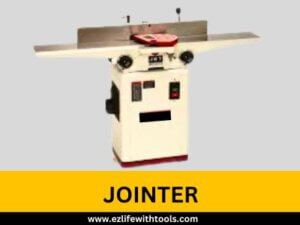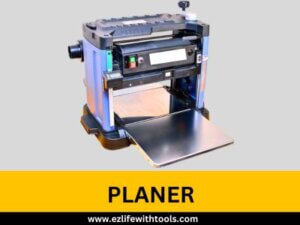Do I Need a Jointer and a Planer Both in Workshop?
Woodworking is not only the name of making wooden products, but it is an art of creativity, precision, and

the joy of transforming raw materials into functional or aesthetic pieces.
In the world of woodworking, these two tools play important roles. Each of them is available with a unique and different set of capabilities.
But when you start your woodworking journey, you can get stuck with a common question: Do I need a jointer and a planer at the same time?
Whether you’re a DIY enthusiast or professional, understanding the functions of these tools will empower you to make the right decision for your woodworking journey.
Let’s start it.
Understanding the Basics of Jointer and Planer
To understand the basics of both we will describe each in details step-by-step. But, first of all learn about the definition and functions of both.
Definition of a Jointer
A jointer is a woodworking tool designed to smooth and flatten wood surfaces. Its primary function is to eliminate twists, warps and bows from raw wood, creating a flat and even base.
Additionally, a jointer specializes in creating straight edges on boards, which is essential for precise and smooth joints in woodworking projects.
Definition of a Planner
A planer is a woodworking tool used to cut wood to thickness and dimension. It ensures uniform thickness across the boards by removing layers of material, creating a consistent surface.
The planer enhances the overall finish of the wood, making it an essential tool for achieving accurate and polished results in a variety of woodworking projects.
Individual Roles and Functions of Jointer and Planer
It’s time to explain the specific roles and functions of both tools in the world of woodworking.
Let’s start.
Role of a Jointer in Woodworking
Eliminating twists, warps and bows: A jointer, like a woodworking wizard, specializes in turning uneven,

warped planks into pristine, straight-edged masterpieces.
It handles bends, warps, and bows with precision, ensuring your starting material is impeccably flat.
This function is especially important when working with rough wood, where irregularities can be very large.
Improving the quality of joinery: Suppose you’re building a tabletop, and the success of your project depends on smooth joints. It is possible only by creating straight edges on your planks.
Whether you’re working on a simple box joint or a complex dovetail, it provides a foundation for tight-fitting joints to enhance the structural integrity and aesthetics of projects.
Role of a Planner in Woodworking
To ensure uniform thickness in wood: In the realm of woodworking, consistency is key. This uniformity is

important for projects like flooring, where differences in board thickness can lead to uneven surfaces.
The planer can produce uniform thickness across multiple boards. It is a hallmark of its functionality.
Increasing overall level of completion: In addition to thickness, the planer contributes to the ultimate aesthetic appeal of your woodwork. As it shaves the layers to achieve the desired thickness, it also provides a smooth and uniform surface finish.
This feature especially helps when working on projects that require a polished, professional look.
Assessing Your Woodworking Needs
When you are going to choose one of both tools, it’s very important to understand your specific needs that Do I need a Jointer and a Planer for woodworking projects or not?
Let’s explain it.
- DIY and hobby considerations
- Professional Woodworker Considerations
1- DIY and hobby considerations
Simplicity of projects: If you are working on a simple project like shelves, small furniture items, or basic carpentry, a jointer alone may be sufficient.
The Jointer has the ability to meet the basic needs of these projects without the addition of a complex planer.
Budget Constraints: DIYers often face budget limitations. If you’re trying to optimize your initial investment, evaluating if both a jointer and a planner are important.
In such cases, starting with a jointer may be a more economical choice, allowing you to achieve smooth surfaces and straight edges while keeping costs down.
2- Professional Woodworker Considerations
Accuracy and Performance Requirements: In the field of professional woodworking, accuracy and efficiency are paramount.
Suppose your projects require precision, uniform thickness across multiple pieces, and a polished finish. In that case, a combination of the two tools ensures you meet the high standards expected in professional craftsmanship.
Frequency of use in large-scale projects: For professionals engaged in large-scale woodworking endeavors, the time saved by using both tools can be significant.
A jointer for initial surface preparation and a planer for achieving consistent thickness streamline the workflow, allowing for faster and more efficient production.
Do I Need a Jointer and a Planer Both in Workshop?
Pros and Cons of Jointer and Planer
As we navigate the decision-making process of adding jointers and planers to your woodworking toolkit, understanding the specific benefits and limitations of each tool is paramount.
Pros of a Jointer
- The Jointer specializes in creating smooth, straight edges on boards.
- It creates structurally and visually appealing projects.
- Jointer is indispensable for surface preparation and elimination of twists, warps and bows.
- Its accuracy in creating flat surfaces contributes to the overall quality of your woodwork.
Cons of a Jointer
- If your plans primarily involve achieving consistent thickness across multiple boards, more than a Jointer is required.
- The Jointer falls short when it comes to achieving uniform thickness.
Pros of a Planner
- Planar flashing helps achieve uniform thickness in planks.
- It ensures that all your boards are the same thickness, contributing to a professional and glossy finish.
- It can enhance the overall surface finish to provide a smooth and consistent appearance.
- It is especially beneficial for projects where a polished look is essential.
Cons of a Planner
- Alone, the planner doesn’t have the ability to correct the irregularities of raw material.
- It is only designed for thickness and surface finish but does not have ability to correct twists, warps or bows.
Budget and Space Considerations of Jointer and Planer
Analyzing the cost of both tools and required space for them, is very crucial before buying any one tool.
Jointer’s Cost and Space Requirement
Benchtop models of Jointer are affordable and suitable for smaller projects. For hobbyist persons, it is very cost-effective.
If space is limited, choosing a benchtop jointer may be a more practical solution. These compact versions are more adaptable to smaller workspaces while providing essential functionality.
Planner’s Cost and Space Requirement
Thickness planers, especially portable models, can be relatively inexpensive. However, larger, more powerful planers designed for professional use may represent a greater investment.
Planers, especially thickness planers, also come in different sizes. Portable planners are often favoured for their space-saving design. However, larger planers designed for industrial or heavy-duty use may require more floor space.
The Alternative of Separate Jointer and Planer
Due to limited budgets and space, combo machines can be a viable solution for woodworkers. These hybrid tools provide the benefits of both machines, minimizing the financial investment.
Although combo machines offer versatility and space efficiency, the trade-offs must be weighed. They may not match the specialized skills of dedicated joiners and planners, especially in professional settings.
However, for hobbyists or those with limited space, the convenience and cost-effectiveness of combo machines can make them a practical compromise.
Conclusion
The choice between a jointer and a planer, or both, is highly dependent on your circumstances. There is an aim behind providing the facts in this article, which is to empower you with the knowledge to make the right selection.
Whether you’re working on simple DIY projects or engaged in professional woodworking endeavours, these tools play a pivotal role in the success of your creations.
Remember, the ideal toolkit is your helping hand to align your objectives.
Now, go and enjoy your journey in the world of woodworking.
Thank you for your time.
Best wishes

